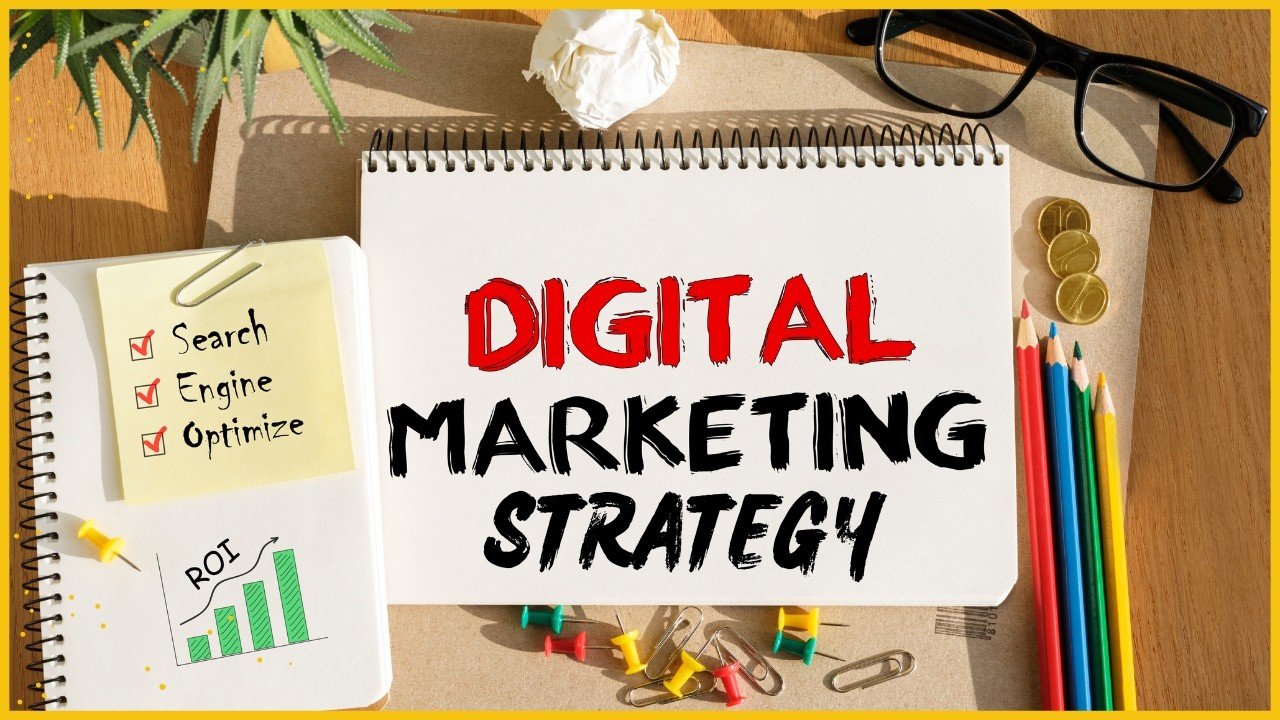10 Steps to Develop a Digital Marketing Strategy
Welcome to our channel! In today’s video, we’ll walk you through the process of developing a successful digital marketing strategy. Whether you’re starting from scratch or looking to refine your existing strategy, these steps will help you create a comprehensive plan to achieve your marketing goals. Let’s dive in!
Step One: Understanding Digital Marketing Strategy
A digital marketing strategy is a comprehensive plan that outlines how you will use digital channels to achieve your marketing goals. It involves understanding your audience, setting clear objectives, and choosing the right tactics to reach and engage your audience. A well-rounded strategy integrates multiple digital channels such as social media, email, search engines, and content marketing to create a cohesive approach.
Nike employs a comprehensive digital marketing strategy that includes social media influencer partnerships, email marketing, and content marketing to maintain its brand dominance and engage with its audience globally. For instance, Nike collaborates with top athletes and influencers on Instagram to showcase their latest products and inspire their audience.
Another example is HubSpot. A leading B2B software company, HubSpot uses content marketing and SEO strategies to generate leads. Their blog posts and downloadable resources educate potential customers on marketing and sales solutions, driving traffic and conversions through organic search.
Chipotle leverages social media and local SEO to boost its online presence and attract more customers to its restaurants. Chipotle uses platforms like TikTok and Instagram to showcase their sustainable sourcing and engage with younger demographics effectively.
Step Two: Setting Clear Goals
The first step in developing a digital marketing strategy is setting clear, measurable goals. These goals will guide your efforts and help you track your progress. Use the SMART criteria to set specific, measurable, achievable, relevant, and time-bound goals. For example, a company aims to increase its website traffic by 30% in the next 6 months through various digital campaigns focused on personalized content and influencer partnerships.
Another goal could be to generate 500 new leads per month through content marketing efforts targeting decision-makers with insightful white papers and webinars. Or, a company might target a 20% boost in social media engagement over the next quarter with interactive and engaging content such as user-generated campaigns and live events.
Step Three: Understanding Your Audience
Next, you need to understand your audience. Conduct market research to identify your target audience’s demographics, interests, and behaviors. Create detailed buyer personas to represent your ideal customers. Gather data from various sources, including surveys and analytics. Creating buyer personas helps you tailor your marketing messages to specific segments of your audience.
Amazon conducts extensive surveys and interviews to gather insights directly from their customers. They use this data to tailor their recommendations and marketing campaigns effectively. Another good example is Spotify. Spotify utilizes tools like Google Analytics and social media insights to analyze user behavior and preferences. This data helps Spotify recommend personalized playlists and music suggestions to its users.
Step Four: Choosing the Right Channels
Based on your audience research, choose the digital channels that are most effective for reaching your target audience. This could include search engines, social media, email marketing, and more. Understand where your audience spends their time online and how they prefer to consume content. Choose channels that best support your content format, like videos or blog posts.
Sephora focuses on Instagram for its visually appealing content to engage a younger audience passionate about beauty trends and tutorials. Another example is LinkedIn. LinkedIn is a primary channel for IBM to reach B2B clients and professionals for networking and lead generation. IBM shares thought leadership articles and industry insights to establish credibility.
Step Five: Creating High-Quality Content
Create high-quality, valuable content that addresses your audience’s needs and interests. This could include blog posts, videos, infographics, and more. Content should be informative, engaging, and optimized for search engines. Use various formats to cater to different audience preferences.
Buffer writes blog posts that provide solutions to common social media marketing challenges, attracting a large audience of marketers seeking practical insights and tips. Another example is Apple. Apple creates how-to videos that demonstrate the use of their products, enhancing customer experience and knowledge while showcasing the latest features of their devices. IBM designs infographics that present complex information about their technologies in an easy-to-understand format, educating their audience about the impact of AI and cloud computing.
Step Six: Implementing SEO Best Practices
To increase organic traffic, implement SEO best practices. This involves optimizing your website and content for search engines so that your target audience can easily find you online. SEO includes keyword research, on-page optimization, and link building. Conduct keyword research to understand search terms and optimize your content accordingly.
NerdWallet conducts thorough keyword research to identify relevant search terms in the personal finance niche and incorporates them into their content. By understanding search intent and optimizing their articles, NerdWallet improves their search engine rankings and attracts more organic traffic.
HubSpot optimizes their website’s meta tags, headers, and images for better search engine visibility, ensuring that their educational content ranks well for relevant industry keywords. Shopify creates high-quality backlinks by guest posting on reputable sites and collaborating with industry influencers, enhancing their domain authority and driving qualified traffic to their e-commerce platform.
Step Seven: Leveraging Social Media Marketing
Social media is a powerful tool for building brand awareness and engaging with your audience. Develop a social media strategy that includes regular posting, engaging content, and interaction with followers. Create content that resonates with your audience and encourages interaction. Use social media metrics to refine your strategy and maintain strong audience engagement.
GoPro showcases user-generated content and high-quality action videos to engage their adventure-loving audience on its social media channels. Another example is Lululemon. Lululemon hosts live sessions and Q&A segments on Instagram to interact directly with their audience, share yoga and fitness tips, and promote new product launches effectively.
Target runs targeted ads on platforms like Facebook and Instagram to reach a broader audience, showcasing seasonal promotions and driving traffic to their online store and brick-and-mortar locations.
Step Eight: Utilizing Email Marketing
Email marketing remains one of the most effective ways to nurture leads and convert them into customers. Build an email list and send regular, valuable content to your subscribers. Segment your email list to send targeted messages. Regularly sending newsletters, product updates, and special offers keeps your audience engaged and informed.
MailChimp creates a lead magnet such as an ebook or free course to encourage signups and grow their email list of small business owners and marketers seeking email marketing solutions. Amazon segments their email list based on purchase history and browsing behavior, sending personalized product recommendations and exclusive offers to different customer segments.
Netflix uses automated email sequences to nurture leads and guide them through the subscription funnel, highlighting new releases and personalized content recommendations based on viewing preferences.
Step Nine: Monitoring and Analyzing Performance
To ensure your digital marketing strategy is effective, continuously monitor and analyze your performance. Use analytics tools to track key metrics and adjust your strategy based on the data. Tracking performance involves using tools like Google Analytics and social media insights. Regular analysis helps you identify what’s working and make data-driven decisions.
Most companies use Google Analytics to track website traffic, user behavior, and conversion rates across their various products and services, optimizing their marketing efforts and user experience. Many companies also monitor social media metrics such as engagement, reach, and follower growth to refine their social media marketing strategies and maintain strong audience engagement.
MailChimp analyzes email marketing metrics like open rates, click-through rates, and conversions to optimize their email campaigns, ensuring relevant and engaging content for their subscribers.
Step Ten: Adjusting Your Strategy
Digital marketing is an ongoing process. Based on your performance analysis, make adjustments to your strategy to improve results. Be flexible and ready to pivot when necessary. Adjust your strategy based on data insights and market changes. Regularly updating your strategy ensures it remains aligned with your business goals and audience needs.
If a particular social media platform isn’t delivering results, companies consider shifting their focus to another platform where their audience is more active, adapting their content strategy to better resonate with their target demographics. BuzzFeed experiments with different content types and formats to see what resonates best with their audience, constantly evolving their content strategy to stay ahead in the digital landscape.
Many companies continuously update their SEO strategy based on the latest search engine algorithms and trends, ensuring their websites rank prominently and maintain high visibility for relevant search queries.
And there you have it, your ultimate guide to developing a digital marketing strategy. By setting clear goals, understanding your audience, choosing the right channels, creating high-quality content, and continuously monitoring your performance, you’ll be well on your way to digital marketing success. Thanks for watching! Don’t forget to like, share, and subscribe for more valuable content. Until next time, happy marketing!
This video is brought to you by Romo AI. Romo AI is an all-in-one AI platform with over a dozen super AI tools inside a single dashboard for the price of one. These tools include AI text writer, AI SEO optimized article writer wizard, AI image generator, AI copywriting tools, AI code writer, AI file reader and analyzer, AI audio creator, AI superbots, and many more amazing AI tools. You can also add your team members to work together on your projects. Visit www.romoai.com and get your free trial account. Use coupon code GET22 to avail a 22% exclusive discount on all packages of Romo AI.


